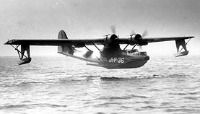
The remains of up to five U.S. airmen lost when their PBY Catalina sunk in Quebec’s Gulf of St. Lawrence in 1942 have been recovered and sent for DNA identification. For the last three weeks the Joint POW/MIA Accounting Command (JPAC)’s USNS Grapple has been on station off Longue-Pointe-de-Mingan, a small fishing village on Quebec’s north shore. Longue-Pointe-de-Mingan was a stop on the so-called “Crimson Line” supply route to Europe during the war. That’s where Parks Canada employees found the Catalina intact in 2009. Because the hull was intact and there might be human remains inside, the workers left the relic alone and called U.S. officials. The recovery effort has been successful. “To be able to do this and bring some closure to families is pretty rewarding,” Stefan Claesson, a forensic archaeologist aboard the Grapple told reporters. “As long as we find one remain it’s a success for us. And in this case we have a significant number of remains to bring back home, so that’s very exciting.” Also remarkable is that 70 years later there are still eyewitnesses to the crash living in the town.
It was Josephine Vibert’s wedding day and she clearly recalls watching the big flying boat pounding through big swells trying to get airborne. On the second takeoff attempt, she said, waves inundated the aircraft. “I counted five waves, but there may have been more,” Vibert said. “After the last one, water started entering their plane.” Four airmen were rescued by local fishermen but five crew members went down with the PBY. It rested upside down 150 feet below the surface, the intense cold and darkness preserving not only the remains but a treasure trove of war-era artifacts. Aviator’s glasses, a sealed bottle of Listerine, photo negatives and even paper from what might have been one of the aircraft’s logs have been recovered. There are no immediate plans to recover the aircraft.


































